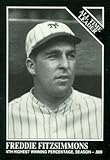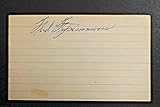Fitzsimmons (217-146 record in his career) holds a 3.51 ERA 0 9.3 hits per 9 innings. He has a strikeout to walk ratio of 1.03 and he has faced 13,570 hitters in his MLB career. During his MLB career, Fitzsimmons has conceded 3,335 base knocks while he has earned 870 strikeouts in 3,223 innings pitched. He has surrendered a total of 1,257 earned runs while holding a WHIP of 1.297 and being the owner of a FIP of 3.5.
Freddie Fitzsimmons, often affectionately known as “Fat Freddie,” was a prominent Major League Baseball (MLB) pitcher renowned for his unique pitching style and impressive career achievements. Born on July 28, 1901, in Mishawaka, Indiana, Fitzsimmons left an indelible mark on the baseball world with his exceptional skills and sportsmanship. This article delves into the life and career of Freddie Fitzsimmons, shedding light on his journey, pitching prowess, and lasting legacy.
Early Life and Career Beginnings
Freddie Fitzsimmons grew up in a working-class family in Indiana. From an early age, he showed a keen interest in baseball, often playing with local teams. His talent on the field did not go unnoticed, and by the time he was in his late teens, he was already making waves in the local baseball scene.
In 1920, Fitzsimmons caught the attention of professional scouts and began his professional career with the Indianapolis Indians, a minor league team. His performance was nothing short of spectacular, and he quickly rose through the ranks, earning a spot in the major leagues with the New York Giants in 1925.
The New York Giants Era
Fitzsimmons spent the majority of his career with the New York Giants, where he became a key figure in their pitching rotation. Known for his unorthodox windup and delivery, Fitzsimmons baffled batters with his “knuckle curve” pitch. This pitch, which he perfected over years of practice, was incredibly difficult for hitters to read, making him a formidable opponent on the mound.
During his tenure with the Giants, Fitzsimmons was part of several memorable moments. He played a crucial role in helping the team reach the World Series in 1933, where they triumphed over the Washington Senators. His ability to deliver under pressure made him a reliable asset in critical games.
The Move to the Brooklyn Dodgers
In 1937, Freddie Fitzsimmons was traded to the Brooklyn Dodgers, marking a new chapter in his career. Despite initial concerns about his age and fitness, Fitzsimmons proved his critics wrong by maintaining his top form. His experience and leadership qualities were invaluable to the Dodgers, helping them improve their pitching lineup.
| # | Preview | Product | Price | |
|---|---|---|---|---|
| 1 |

|
MLB | Buy on Amazon | |
| 2 |

|
2025 Topps Series 1 Baseball - Factory Sealed - Value Box |
$39.51 |
Buy on Amazon |
With the Dodgers, Fitzsimmons continued to showcase his remarkable pitching abilities. He remained a consistent performer, contributing significantly to the team’s successes during his tenure. His dedication to the game and his teammates earned him respect both on and off the field.
Pitching Style and Signature Moves
Freddie Fitzsimmons was known for his distinctive pitching style, characterized by a high leg kick and a deceptive delivery. His unique approach often left batters guessing, as his pitches appeared to come from unexpected angles. The “knuckle curve,” his signature pitch, was especially challenging for hitters to anticipate, often resulting in strikeouts or weak contact.
Fitzsimmons’ mastery of the knuckle curve and his ability to adapt to various game situations made him a versatile pitcher. He had an exceptional understanding of the game, often outsmarting opponents with his strategic mindset and precise execution.
Legacy and Impact on Baseball
Freddie Fitzsimmons retired from professional baseball in 1943, leaving behind a legacy that continues to inspire future generations of players. His career statistics are a testament to his prowess on the mound, with over 200 wins and a remarkable winning percentage. Fitzsimmons’ contributions to the game earned him a place in the hearts of fans and fellow players alike.
Beyond his on-field achievements, Fitzsimmons was admired for his sportsmanship and dedication to the sport. He remained involved in baseball after retirement, sharing his knowledge and experience as a coach and mentor to young players. His influence extended beyond the diamond, shaping the careers of many aspiring athletes.
Remembering “Fat Freddie”
Despite his nickname, “Fat Freddie” Fitzsimmons was anything but ordinary. His impact on the game of baseball is undeniable, and his story serves as a reminder of the power of determination and passion. Fitzsimmons’ journey from a small-town boy to a celebrated MLB pitcher is a testament to his hard work and resilience.
In the world of baseball, Freddie Fitzsimmons will always be remembered as a remarkable pitcher who defied conventions and left an enduring legacy. His contributions to the New York Giants and Brooklyn Dodgers, as well as his influence on the sport, continue to be celebrated by fans and historians alike.
Conclusion
Freddie Fitzsimmons’ career is a shining example of what can be achieved through talent, dedication, and perseverance. As one of the most notable pitchers of his time, Fitzsimmons’ legacy lives on in the annals of baseball history. From his early days in Indiana to his triumphs in the MLB, Freddie Fitzsimmons remains a symbol of excellence and sportsmanship in America’s favorite pastime.
As we remember “Fat Freddie,” we celebrate not just his achievements on the field, but also his contributions to the spirit of the game. His story is a reminder that greatness is not defined by physique or convention, but by the heart and determination of the individual.























